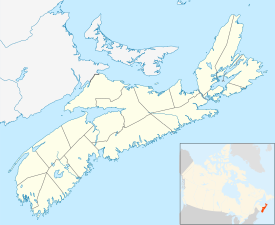Bridgetown, Nova Scotia
| Bridgetown | |
|---|---|
| Community | |
| Location of Bridgetown, Nova Scotia | |
| Coordinates: 44°50′29″N 65°17′22″W / 44.84139°N 65.28944°W | |
| Country |
|
| Province |
|
| County | Annapolis County |
| Founded | 1783 |
| Incorporated | September 15, 1897 |
| Dissolved | April 1, 2015 |
| Electoral Districts Federal |
West Nova |
| Provincial | Annapolis |
| Government | |
| • MLA | Stephen McNeil (L) |
| • MP | Colin Fraser (L) |
| Area | |
| • Land | 3.54 km2 (1.37 sq mi) |
| • Urban | 3.65 km2 (1.41 sq mi) |
| Population (2011) | |
| • Community | 949 |
| • Density | 267.8/km2 (694/sq mi) |
| • Urban | 1,014 |
| • Urban density | 277.5/km2 (719/sq mi) |
| Time zone | AST (UTC-4) |
| Postal code | B0S 1C0 |
| Area code(s) | 902 |
| Telephone Exchange | 312, 588, 665 |
| Median Earnings* | $38,248 |
| Website | bridgetown.ns.ca |
|
|
Bridgetown is a Canadian community located in north-central Annapolis County, Nova Scotia.
Situated on the Annapolis River at the head of the tide, the area saw Mi'kmaq settlements, followed by Acadian settlers from Port-Royal and then British-sponsored settlements by the late 18th century.
There were at least ten Acadian settlers in the Bridgetown area before the French census of 1671, and the population doubled by 1707. The main Acadian settlement was on the east boundary of the present town, called Gaudetville. There were other Acadian settlers in the town proper, some of whom lived just east of the present bridge.
Several armed skirmishes occurred in neighbouring Carleton Corner during Queen Anne's War (the Battle of Bloody Creek (1711)) and several decades later, the Seven Years' War (the Battle of Bloody Creek (1757)).
Deed references suggest British settlement in Bridgetown from the early 1760s onward, after the Acadians were expelled from Nova Scotia in 1755. These settlers appeared shortly after the allocation of Granville Township among its proprietors; Bridgetown is located in what was formerly Granville Township, settled from 1760 on. The central part of Bridgetown was referred to as the Farm of Henly for unknown reasons. The community grew into a successful wooden shipbuilding area during the 19th century, accounting for many grand homes. It was incorporated as a town in 1897. The town was actually an entrepot for the agricultural and forest products of the surrounding areas and became a significant manufacturing and commercial centre in the 19th century. Manufacturing included a furniture factory, an organ factory, a tannery, a bottling plant, a cider plant, the first M.W. Graves cannery and vinegar factory (Graves was a major food processor that later moved to Kings County) and a distillery.
...
Wikipedia

